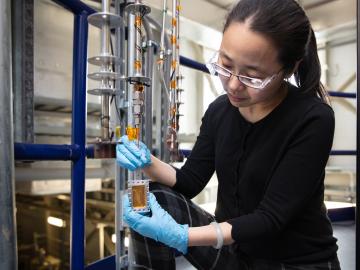
Filter News
Area of Research
- (-) Biological Systems (1)
- (-) Materials (76)
- (-) Nuclear Science and Technology (10)
- Advanced Manufacturing (2)
- Biology and Environment (112)
- Biology and Soft Matter (1)
- Computational Biology (2)
- Computational Engineering (3)
- Computer Science (6)
- Electricity and Smart Grid (1)
- Energy Science (90)
- Functional Materials for Energy (1)
- Fusion and Fission (5)
- Isotope Development and Production (1)
- Isotopes (28)
- Materials for Computing (12)
- Mathematics (1)
- National Security (36)
- Neutron Science (31)
- Quantum information Science (4)
- Sensors and Controls (1)
- Supercomputing (73)
News Topics
- (-) Big Data (2)
- (-) Biomedical (9)
- (-) Cybersecurity (5)
- (-) Environment (16)
- (-) Isotopes (16)
- (-) Microscopy (27)
- (-) Polymers (17)
- (-) Security (2)
- (-) Space Exploration (7)
- 3-D Printing/Advanced Manufacturing (26)
- Advanced Reactors (14)
- Artificial Intelligence (9)
- Bioenergy (14)
- Biology (4)
- Buildings (5)
- Chemical Sciences (32)
- Clean Water (3)
- Composites (9)
- Computer Science (19)
- Coronavirus (5)
- Critical Materials (13)
- Energy Storage (34)
- Exascale Computing (2)
- Frontier (3)
- Fusion (15)
- Grid (5)
- High-Performance Computing (4)
- Irradiation (1)
- ITER (1)
- Machine Learning (5)
- Materials (73)
- Materials Science (79)
- Mathematics (1)
- Molten Salt (7)
- Nanotechnology (39)
- National Security (3)
- Neutron Science (38)
- Nuclear Energy (49)
- Partnerships (11)
- Physics (30)
- Quantum Computing (3)
- Quantum Science (11)
- Simulation (1)
- Summit (2)
- Transportation (14)
Media Contacts

In the race to identify solutions to the COVID-19 pandemic, researchers at the Department of Energy’s Oak Ridge National Laboratory are joining the fight by applying expertise in computational science, advanced manufacturing, data science and neutron science.

Scientists at Oak Ridge National Laboratory used a focused beam of electrons to stitch platinum-silicon molecules into graphene, marking the first deliberate insertion of artificial molecules into a graphene host matrix.

OAK RIDGE, Tenn., Feb. 27, 2020 — Researchers at Oak Ridge National Laboratory and the University of Tennessee achieved a rare look at the inner workings of polymer self-assembly at an oil-water interface to advance materials for neuromorphic computing and bio-inspired technologies.

Liam Collins was drawn to study physics to understand “hidden things” and honed his expertise in microscopy so that he could bring them to light.

Students often participate in internships and receive formal training in their chosen career fields during college, but some pursue professional development opportunities even earlier.

If humankind reaches Mars this century, an Oak Ridge National Laboratory-developed experiment testing advanced materials for spacecraft may play a key role.

Researchers at the Department of Energy’s Oak Ridge National Laboratory have received five 2019 R&D 100 Awards, increasing the lab’s total to 221 since the award’s inception in 1963.

A team of researchers at Oak Ridge National Laboratory have demonstrated that designed synthetic polymers can serve as a high-performance binding material for next-generation lithium-ion batteries.

Scientists have discovered a way to alter heat transport in thermoelectric materials, a finding that may ultimately improve energy efficiency as the materials

Researchers at the Department of Energy’s Oak Ridge National Laboratory, Pacific Northwest National Laboratory and Washington State University teamed up to investigate the complex dynamics of low-water liquids that challenge nuclear waste processing at federal cleanup sites.


